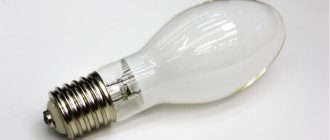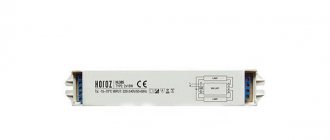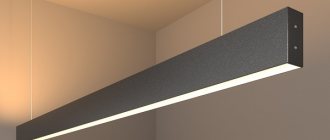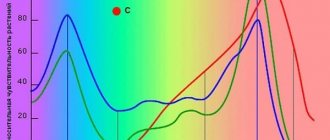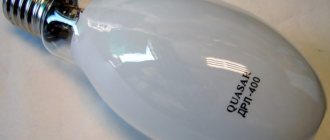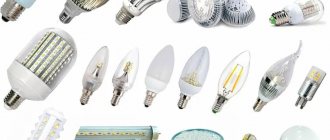Before considering the technical characteristics of a 250 W HPS lamp, you should understand what this light source is, what its design and principle of operation are. Lighting experts are familiar with the product, but for beginners the term “high pressure sodium arc tube lamp” means nothing. In addition, the lamp is made in the form of a tube, and the emitting element is sodium.
DNaT are time-tested, reliable lighting devices, not without disadvantages compared to modern analogues.
Two decades ago, such lamps were used to illuminate highways around the world, but over time they began to be replaced by LED devices. By the way, sodium lamps have not become a thing of the past: experienced designers often include them in their projects, and this is due to a number of reasons. Firstly, the cost of LEDs is much higher, secondly, the energy efficiency of the latter is not so high, and thirdly, the number of manufacturers of LED products is too large, which is why it is sometimes difficult to choose high-quality devices.
DNAT in simple words
HPS lamps abroad are called HPS Lamp, which stands for High-Pressure Sodium Lamp, translated as “high-pressure sodium lamps” and abbreviated in Russian as NLVD. The first NLVDs were produced in the Soviet Union in the form of an ellipse or tube, with a transparent or matte bulb, with or without mirror coating, and of varying power.
It turns out that HPS is a type of NLVD light source, but when choosing a German product from Osram, be prepared to see a name like VIALOX NAV-T 250 W SUPER 4Y.
NLVD also includes other light sources - DNaZ (mirror coating) and DNaS (light-scattering bulb).
Device
According to the established abbreviation DNaT, these are (D - arc, Na - sodium, T - tubular) devices. Based on their operating principle, they belong to high-pressure lighting equipment. Structurally, HPS lamps are a glass bulb with a base, usually E27 or E40.
Rice. 1. Design of a HPS lamp
The internal structure consists of:
- discharge tube - made of aluminum oxides and designed to burn an arc inside the lamp;
- electrodes - designed to start the discharge, which is why they are made of molybdenum;
- gas mixture - acts as a medium for generating light radiation, the main percentage here is occupied by sodium vapor, but argon is included as an impurity to accelerate combustion, and mercury to ensure high light output.
The flask is made of heat-resistant glass, since the gas in the tube can heat up to 1300ºС, as a result of which the HPS lamp itself on the surface will have from 100 to 400 ºС. A vacuum is installed inside the lamp for better light output.
Design
When considering the design of a HPS lamp, we see the following elements:
- glass flask;
- cylindrical tube with aluminum holder.
The cavity of the tube is filled with mercury vapor (as in luminescent sources) and sodium vapor, forming a sodium amalgam. But these are not all gaseous substances: xenon is used to start the product.
HPS comes in both high and low pressure. This parameter is essentially related to the color temperature: in the first case, the lamp has a light yellow tint, in the second - muted yellow (like halogen and incandescent lamps).
Xenon is located inside the burner, which ensures a smooth start-up of the equipment. To increase service life, two burners can be used simultaneously.
Burner
The same cylindrical tube mentioned above. Made from transparent ceramics, resistant to high temperatures and chemically active substances. It was first manufactured by General Electric in 1960 and patented under the name “lucalos” (we know it as “polycor”). Its creation is based on the technology of sintering aluminum oxide at high temperatures. Tungsten electrodes are soldered to the two ends of the tube.
Inside it there is a mixture of inert gases and sodium amalgam under a pressure of 100 kPa and above, which makes it easy for an electrical discharge to occur due to the higher density of the medium, and also expands the region of the visible spectrum.
Base
To connect to the power lines, an Edison type E threaded socket is used. For HPS lamps with a power of 50, 70 and 100 watts, size E27 is used, for more energy-intensive models of 150, 250 and 400 watts - E40. The number indicates the diameter of the cartridge in millimeters.
DNAZ lamps
DNAZ, by the way, is one of those domestic products that we (our entire editorial team) are sincerely proud of. No seriously. You will not find a more erotic solution in lighting technology in its simplicity and brevity.
DNAZ lamp 600 W with IP68 socket
Engineers have been struggling for years with the problem of the high temperature of the protective flask, with simple ways of forming the CSC, with minimizing losses in the lamp, and with reducing the weight of the lighting device. And voila - Soviet engineer Vladimir Pchelin makes a lamp with internal mirror coating, opens the Reflax company, patents this business and puts it into mass production. Profit.
Schematically, this is roughly how it works
DNaZ lamps are easily used in the plant supplementary lighting sector by such global giants as Osram and Philips. And they are especially popular among Dutch plant growers, which seems to hint.
Vladimir Pchelin and his invention: a DNaZ lamp in a street lamp housing
Returning to the previous point, these lamps have gone viral not only among agronomists, but also among road workers, and their popularity is just beginning to grow. Most of all, we had the opportunity to see DnaZ lamps in the vastness of the Republic of Belarus, although more in rural areas. In Moscow they really like to put them in courtyards. And just a few months ago they illuminated one of the streets of Dolgoprudny, despite the fact that LED lights were being installed on the neighboring street. Pilot comparison?
Street lamp with DNaZ lamp
As part of the Verified-Lumen section, we were able to test one street lamp using a DNaZ lamp. Because Since the lamp has a built-in reflector to form a wide axial reflector, and its bulb simultaneously serves as protective glass, we can safely say that the measured characteristics of the lamp = the measured characteristics of the lamp (except for power). And, for a second, we got an honest 114 lm/W with a lamp weight of 2.5 (!) kg, a luminous flux of 30,000 (!) lumens and a cost of 7,500 rubles . Actually here it is.
In general, the DNAZ lamp, together with its inventor, deserve a separate article. And we will definitely write it. No. Seriously. Apart from the company's own website, you will find almost no information about this lamp. So we'll fix this.
Operating principle
For an electric charge to occur in a gaseous medium, a high voltage pulse is required. Since sodium melts at a fairly high temperature, the electric charge ignites slowly: low-power HPS produces a full luminous flux after 5-6 minutes, and high power - after 10-15 minutes.
At the moment of startup, the environment is cold, its electrical resistance is low, so the process is accompanied by an avalanche-like increase in current in the circuit, which can cause overheating and destruction of the lamp electrodes. Therefore, the DNAT control gear includes an electronic ballast (choke) - an inductor without a core. Compensation occurs due to the emergence of a magnetic flux directed opposite to the current that generated it.
Typical frequently asked questions from readers
There is a DNAT-400 that recently stopped turning on. Could this be due to low voltage in the final electrical circuits?
Alternatively, it is possible that the voltage level in the final electrical circuit is not enough, but I would like to know more detailed details. Does the lamp not light up at all or does the warm-up time last longer than usual? Are there any light effects when you turn it on or does the lamp not even flicker?
In addition to such a possible cause as low voltage in the electrical terminals, the lamp should be checked for the following faults:
The ignition device is faulty - due to natural wear and tear of the elements or with frequent switching without waiting a break between switching on, the ignition device may fail. Replacing with a new one can completely solve the problem, but you need to select something similar.
The cartridge has burned out - many connection points in gas-discharge lamps suffer due to the increased voltage supplied to the lamp. Therefore, the cartridges may not withstand the electrical load and simply burn out. To eliminate the problem, replace the cartridge with a new one.
Connecting wires also burn out in the area from the IZU to the lamp due to high voltage and the load applied to them. Such a malfunction can be determined even by visual inspection.
The lamp itself has burned out - this can be checked by visual inspection or by replacing it with a similar working one.
Comparison of technical characteristics
The table below presents a comparison of the technical characteristics of a high-pressure mercury gas discharge lamp (HPD) and a tubular sodium arc lamp (HSA) of the same power - 250 W.
| DRL-250 | DNAT-250 | |
| Power, W) | 250 | 250 |
| Specific luminous flux (Lm/W) | 45 | 90 |
| Total Luminous Flux (Lm) | 13500 | 28000 |
| Continuous operation time (hour) | 12000 | 20000 |
| Base type | E40 | E40 |
| Color temperature (K) | 3800 | 2000 |
| Color rendering index (Ra) | 45 | 25 |
| Full warm-up time (min) | 5–10, depending on ambient temperature | |
| Length (mm) | 228 | 250 |
| Bulb diameter (mm) | 91 | 48 |
Ignition and launch
When voltage is first applied, the lamp starts to ignite. This starting stage and reaching maximum brightness can take from 5 to 10 minutes.
The glow color should be bright yellow up to 150 lm per watt.
If street lighting made by such models has an irritating, dirty orange tint, this means only one thing - no one has washed the lampshades for a long time, and there is dust and dirt on them.
High-quality, good lamps always produce a pleasant orange spectrum.
HPS lamps are very stable and are not afraid of various types of vibrations and shocks.
Advantages and disadvantages of DNAT
The advantages of this type of lamp are visible from the table above. First of all, it has greater energy efficiency. The working resource is also significantly higher. Due to its compactness, it can be installed in smaller luminaires. The color temperature matches natural sunlight. At this spectral frequency, the luminous flux is not affected by snow flakes, raindrops, fog or dust.
It also has its drawbacks. The time it takes to reach full luminous flux is very long - in severe frost, DNAT 250 can flare up to full power only after 15 minutes (the time depends on the power of the light source) . Due to the low color rendering index, interior items may have a completely different appearance when illuminated. During operation, flickering appears from an industrial network with a frequency of 50 Hz, which has a negative effect on the visual apparatus. You won't be able to work for long in this light.
Possible faults
Various problems may appear during lamp operation. Sometimes it happens that the HPS 250 blinks, then the light source may have to be replaced. If after this the problem does not disappear, then this may be due to the fact that the voltage in the network is too low.
The light bulb may periodically go out due to poor contact or power surge. Another possible reason is an interturn short circuit, then the insulation of the coil windings is broken. To correct the problem, replace the ballast.
If the new lamp is flashing and the throttle and ignition device are working properly, then give the device time to warm up.
Sometimes it happens that the IZU cracks, but the lamp does not light up. This may be due to the fact that the wire leading from the light source to the ignition device has broken. Then you need to check the wiring and clean the contacts.
Areas of application
First of all, sodium lamps are used for street lighting, on lampposts on highways and other objects where suspended particles in the air can adversely affect safety. The light of sodium arc lamps is able to break through thick fog, rain and snow, which cannot be said about energy-efficient LED lamps.
Due to the high content of ultraviolet and infrared waves, the equipment is used in greenhouses. It has a beneficial effect on the development and fruiting of the plant, warming the air and accelerating photosynthesis.
It is strictly prohibited to use HPS at work sites where accurate color recognition is required.
Installation and connection features
Despite the fact that sodium lamps have a wide range of applications, they are mainly used in the organization of street lighting. This is due to insufficient transmission of the color spectrum. In this case, there is no particular difference in what position the lamps will be located. At the same time, as long-term practice shows, their most effective position is horizontal. In this case, the main light flux is emitted in different directions.
To properly connect the lamps, as we now know, you cannot do without the help of third-party “equipment”. We are talking about ballast, or in other words, a choke for HPS, as well as a pulse triggering device (IZU). Without this, the sodium lamp will simply refuse to start. They have already been mentioned, but now it’s time to get to know them better.
Connection diagrams
To connect the HPS to the network, ballast equipment is used, consisting of a ballast choke and a high-voltage pulse source (HVPS). The first element is connected in series, and the second - in parallel with the lamp. The current passing through the inductor and the IZU starts the lamp.
The power of the choke must correspond to the power of the light source. And it is connected precisely to the phase line, which can be determined using a simple indicator screwdriver. To compensate for the reactive component of the current and reduce energy consumption, a quenching capacitor is connected in parallel with the lamp. For DNAT-250, you can use a model with a capacity of 35 μF. This is an optional schema element.
There is no consensus among electrical engineers regarding the use of IZU. The fact is that there are two types:
- with two connection points;
- with three connection points.
Two-point IZU
The self-oscillation generator circuit is built on two dinistors. It is switched on in parallel with the lamp, so the device does not have a balancing effect on the electrical circuit when the starting current increases. Because of this, the throttle may be broken. After starting the lamp, the IZU continues to operate, increasing energy consumption.
Three-point IZU
A special feature of the device is that the phase line passes through it and through this circuit it is connected in series with the lamp. Therefore, when starting, its throttle has an additional compensating effect and better stabilizes the system. The circuit is based on the latest generation of semiconductors that have the best performance characteristics. For these reasons, it is preferable to use it.
Connecting a HPS lamp from the DRL choke
Many people wonder whether it is possible to connect such a light bulb from a choke of the same power, designed for a DRL lamp? Theoretically, this is possible, the main thing is to exclude the IZU from the circuit.
However, although the powers may be the same, due to different operating voltages on the lamps, the HPS and DRL ballast will produce different operating output currents.
1 of 2
And this will directly reduce the service life of the lamp (if the current is exceeded), or, on the contrary, will not allow it to reach the calculated luminous flux (at lower current).
There are sodium lamps with built-in ignitors. Some people mistakenly consider them universal and use them directly as a replacement, for example, in lamps with 250W DRL.
On the one hand, it’s a complete benefit. It turns out that with a lower power of 220W instead of 250W, you can easily get a much larger luminous flux.
- DRL luminous flux 250W – 13000Lm
- luminous flux such as DNAT 220W – 18000Lm
No circuit modifications, just change the bulbs and get several thousand lumens more light. However, such models must also be used with ballasts designed specifically for sodium lamps.
Otherwise, this will affect the service life of the lamp.
Precautions for use
The outer bulb of the lamp heats up to a temperature of 250–300 degrees. Celsius. This determines the list of safety measures when working with it.
- Do not touch the lamp bulb for 10–15 minutes after turning it off.
- You should absolutely not touch the flask with your hands without gloves: traces of sweat and grease on the surface will lead to uneven heating and even an explosion.
- Provide good ventilation for the lamp and keep it away from flammable structures. The same applies to the ballast choke, which heats up to 150 degrees. Celsius.
In addition, protect the lamp from impacts: when the bulb explodes, fragments fly over a very long distance. If the burner is damaged, the room or area may be contaminated with mercury.
How to make a sodium lamp lamp
Since it is advisable to use HPS products in the household, the use of such light bulbs is relevant for many. But for their operation you will need special lamps. Their cost is high, so it makes sense to build a lighting device with your own hands.
What will you need?
To complete the task you will need:
- a metal-coated plate, its dimensions should be 35x40 cm;
- aluminum sheet that will be used as a reflective element;
- set of self-tapping screws;
- hammer;
- metal scissors;
- pipe with a diameter of 15 cm.
User Anatoly King Crimson spoke in detail about the preparation for the manufacture of a lamp for a HPS light bulb, as well as the creation of such a device.
https://youtube.com/watch?v=mbmFqzkRe_I
Step-by-step instruction
DIY Assembly Guide:
A metal-coated plate is prepared. It should have a mirror surface on the working side, and also be elastic and rigid. If it is not available, it is possible to install a stainless steel plate; this material is used in chimneys. The reflective element is designed to focus the light energy of the device and direct the lighting flux to the desired location. To calculate the dimensions of a reflex device, you can use special computer software that allows you to accurately calculate the efficiency. The plate is bent manually. When carrying out this task, when the central part is bent, you can use a hammer. The rest of the sheet is bent using a previously prepared pipe. To level the surface, you must act carefully. But this can only be done with your hands. At the next stage, the cartridge with the sodium light source is fixed; it can be secured to the back wall. In this example, it is made from the side cover of the PC processor unit. It is recommended to make holes in advance for ventilation of the system. To make a lid, it must be cut out of metal; special scissors are used for this. The socket is fixed to the back surface of the lighting fixture using homemade pins, the diameter of which is 4 mm. These elements are made from hooks purchased in the store. It is desirable that their threaded part be elongated. This will allow you to make several studs. The reflective device is fixed on the rear wall using special aluminum rivets. Their diameter should be 3.2 mm. If you do everything correctly and securely fasten the elements, the structure will ultimately turn out rigid. Then the throttle element, as well as a high-voltage pulse device, is installed in the lighting device
It is important that these components are suitable in size for the lamp body. For more convenient placement, it is possible to remove the board from the case
But the power plug, as well as the switching device with the filter capacitor element, can be left. The throttle is being installed. This example uses a Galad 250W ballast choke element and is optimally suited to the hull width, height and length. A pulse charger is installed next to it. It should have a wiring diagram for the inductor and light bulb, and you need to follow it. At the next stage, wires must be brought out from the housing to the lighting device; their length should be 3 meters. To connect to the socket, only heat-resistant cables must be used. Their insulation should be made of fiberglass. Then the assembled lighting device is configured; this must be done before using it. The lamp is activated; this must be done in a dark room. You must wait until the sodium light source is completely heated. It is necessary to visually assess the quality of the lighting flux, which is reflected by the reflector device. If necessary, this element is bent, but this should be done before it gets hot.
The reflector adjustment procedure must be performed carefully so as not to catch the light source itself. Otherwise, not only the light bulb may be damaged, but it may also explode. To optimize the luminous flux, you can slightly bend the edges of the so-called parabola on the lamp.
User Dmitriy Rostkov spoke in detail about the creation of a reflective device for a HPS light bulb.
Disposal conditions
The burners of high-pressure sodium lamps contain sodium amalgam, an alloy of sodium and mercury. It is strictly forbidden to throw HPS into containers with regular household waste or bury it in the nearest vacant lot. Disposal of devices is carried out according to the same rules that are adopted for DRL lamps and other devices containing mercury.
High pressure sodium arc lamps have very good technical characteristics. In terms of energy efficiency and service life, they compete with LED light sources, so people will continue to use them in various spheres of life for a long time.
Luminous flux and technical characteristics of a 250 W lamp
Most often, 250W HPS is installed in outdoor lamps since the lamps emit a powerful luminous flux. Thanks to its bright light, the device improves visibility even in the presence of airborne particles.
When choosing a lighting element, you need to study its parameters. This will help you choose the right lighting device and determine the scope of the light source.
Characteristics of DNAT 250:
- Rated power – 250W.
- The voltage on the light bulb is 220W.
- Luminous flux – 26000 Lm.
- Light output – 108 LM/W.
- Color temperature – 2000K.
- Color rendering coefficient – 25Ra.
- Type of detachable connector – E40.
- Lamp diameter – 48 mm.
- Lamp length – 235 mm.
- Operating life – 15,000 hours.



